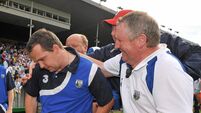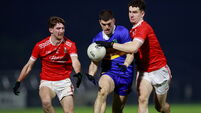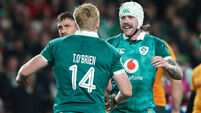Result is still sacrosanct
Books on management make the point that the only constant is change. Trends appear in the preparation of teams and they’re willingly embraced. These are then replaced by the latest in best practice — usually from sports like American Football or Aussie Rules.
They have the financial resources to research and develop modern methods. Ice baths were in vogue seven years ago, but the latest research casts doubts on their effectiveness and they are no longer used.
Use of the internet has really developed since my last time in charge. Sites have comments and assessments about teams and their training methods. It’s difficult to keep any secrets, and even games behind closed doors leak out and are available to the opposition. YouTube regularly features clips from games and training, putting the spotlight on players, which in turn puts pressure on the manager: He’s responsible for everything.
Back then, video analysis wasn’t widely used in hurling. Now, some teams go in for game analysis and statistics in a major way. Last season, one team had seven analysts tracking two individuals during the game.
Updates on how each player was performing was available to the manager throughout the game. Video analysis is also done on the opposition and profiles of opposing players are built up.
The next trend could be where the manager sits. Croke Park has glass cubicles located behind the VIP section of the Hogan Stand as a facility for coaches to view the game and communicate directly. Rugby managers and coaching staff sit in the stand and they’re provided with pictures of the game live. They can show downloaded aspects of the play that they want to correct at half-time.
Hurling managers could occupy these cubicles in time. They afford the opportunity of calm assessment on big match days, but so far the only manager to use this facility was a football manager, banned from the touchline by GAA officials.
No doubt if one is occupied by a hurling manager who wins a game against the odds — and he extols the benefits of the cubicle in the mass media — a trend may develop.
Too much is made in the media of managers patrolling the line, driving on players in major games. I’ve always found the reality to be different. Hurling managers are forbidden to enter the field no matter what the circumstances but they can patrol between the two 45s one metre from the sideline.
However, it’s very difficult for players to hear instructions and unless a manager possesses a voice like a megaphone his influence is limited. Only the “maor fóirne”, who must be a selector, can go on the pitch officially and only during a break in play.
This regulation is ignored from time to time and it sometimes results in substantial fines for the county and a sideline ban for the person involved.
The maor fóirne didn’t exist in 2004 and messages were carried into players by water carriers. Though then, as now, the manager wasn’t allowed to enter the pitch he could move freely around it. This was most useful if you needed to give tactical instructions to a group of players rather than to one individual. The best place for this is near the goalposts where a consultation could take place during a break for an injury.
Remember Brian Cody beside the goal urging his defence to keep Wexford out in the last moments of the 2004 Leinster final. Kilkenny led by two points and an emotional Cody fell to the ground when Michael Jacob plundered the winner for the Slaneysiders with the last puck of the game.
This couldn’t happen today because of the rules but the end line is one area where a manager can effectively communicate with his players and it’s a restriction that I’d like to see relaxed.
Physical preparation has also changed in a big way. Now more than ever the game is based on pace and strength, with a particular emphasis on the latter.
Weight training is now the norm among the majority, where it was the domain of a minority in the early part of this new century. Skill will always bring a player a certain way but upper body strength is now a prerequisite for intercounty hurling.
Another area of change is in the tactical deployment of players. They were always used in military campaigns where one side attempted to outfox the others by employing unexpected offensive or defensive strategies.
Tactics form part of most games, particularly where one team attempts to even up the odds by using players to negate the strengths of their opponents. Dublin did this to good effect recently in their game against Tipp.
Kilkenny’s manager famously stated his side didn’t do tactics in the early 2000s, but they became very tactical after their losses in 2004 and 2005 and in the 2006 final against Cork they used a tactic borrowed from the playbook of Armagh and Tyrone footballers — blocking any runners from half-back or midfield, preventing any combination play as well as withdrawing their forwards for puck-outs, a tactic they have stuck to since.
Most teams’ puck-outs used to be of the Cooley Mountain long puck variety. Fans greeted any short puck-outs or balls back to the ‘keeper with loud derision, but they have now grown used to the tactic and they are accepted as part and parcel of the game.
Brendan Cummins hit seven to his full-back line in the first half against Dublin during the recent All-Ireland semi-final.
Most teams have a defined puck-out strategy: in the Munster U21 final Cork tactically hit their puckouts to the left wing to Aidan Walsh, who scored six points from those possessions while Dublin ‘keeper Gary Maguire, in an obvious pre-planned way, hit everything to the left towards Liam Rushe in the All-Ireland semi-final against Tipp.
Warm-ups have also become a lot more planned, with some teams engaging in little one-on-one and mini-game scenarios. It’s a long way from Wexford’s pre-game warm-up in the NHL final trilogy of 1993, the first on-field warm-up we saw at inter-county level. It was a straightforward warm-up at the town end of Semple Stadium but their players got some razzing from the terraces.
Overall, however, management hasn’t changed that much. It is still about managing the systems in place in the set-up and managing the people in that set-up to maximise the potential during the season.
Entertainment has been mentioned as an important facet of the hurling season by many commentators but managers never feel they have a duty to entertain. If games are entertaining and you win it’s a bonus.
Every manager is still concerned with one objective and that’s to win games while his performance is still judged in the old-fashioned way. It’s still all about results.













